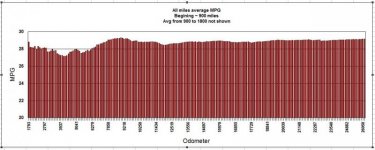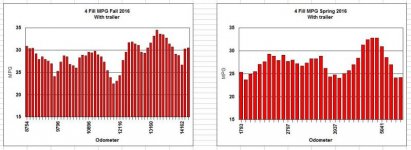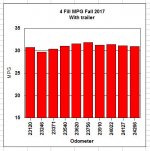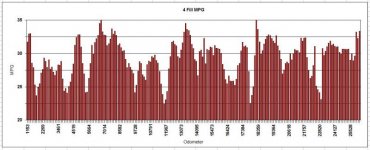And the answer is!!!
This has been an interesting thread, for me anyway! As I've mentioned before I wanted to show just how variable MPG is. If you want to get a somewhat accurate reading of your Spyder's MPG over the long term you need to look at the all miles over the all gallons numbers. Any short period isn't going to be meaningful at all, IMO. The all miles average smooths out the variation due to driving conditions and habits.
I goofed on the graph for All Miles Average MPG. I used a wrong number for the beginning of the graph. I should have looked at it closer right from the start since it didn't quite make sense that the early overall MPG was so low. I'm surprised no one asked about it. Here's a corrected graph. The impact of the mistake is very little from about 9000 miles on. Since tank to tank MPG varies widely the MPG for the first few hundred miles also varied widely. That's why the graph starts at about 700 miles. After about 9000 miles the MPG stays quite constant.

Take a look at these graphs. They show my MPG while pulling my tent-on-a-trailer on two long trips in 2016 and one ~1000 mile trip in 2017. As you can see the 2017 MPG doesn't vary as much as the 2016. That's for two reasons. First there are fewer fill ups represented, and second, the 2017 trip was all 2 lane highways, much at speeds less than 50 mph.


If you look at the 4 Fill MPG graph the higher MPGs mostly were when I was on two lane roads riding about 60 mph and below. The low MPG are mostly Interstate roads at 70 mph and above. The really low numbers were when I was bucking strong head winds. This is the case whether or not I was pulling my trailer.
Now, before I tell you which poll option best matches my fuel selection for the two riding seasons take another look at the 4 Fill MPG graph.

What can you tell about when I used regular and when I used premium? 68 percent of you selected the option of premium for both seasons.
Go to the next post for the answer!!




